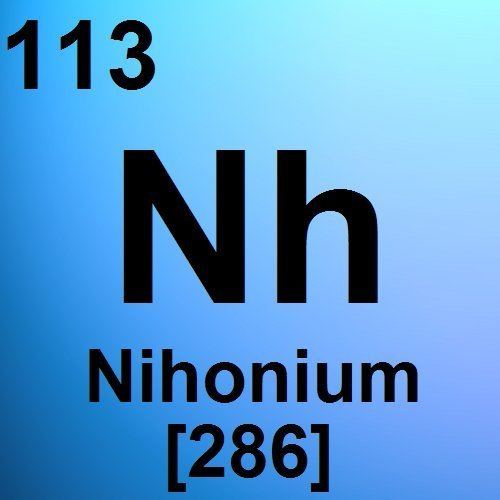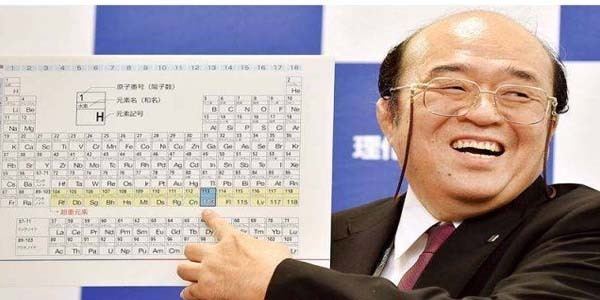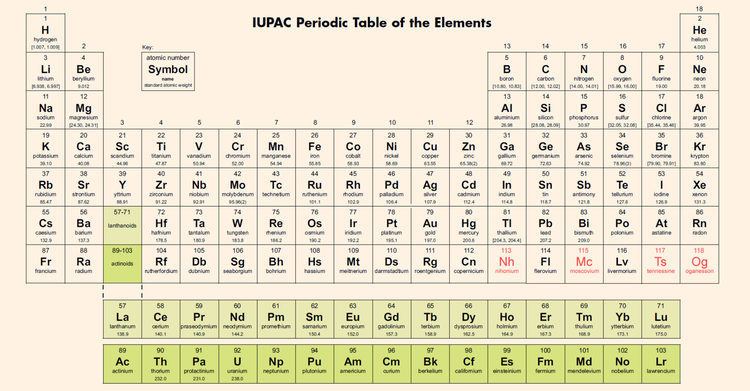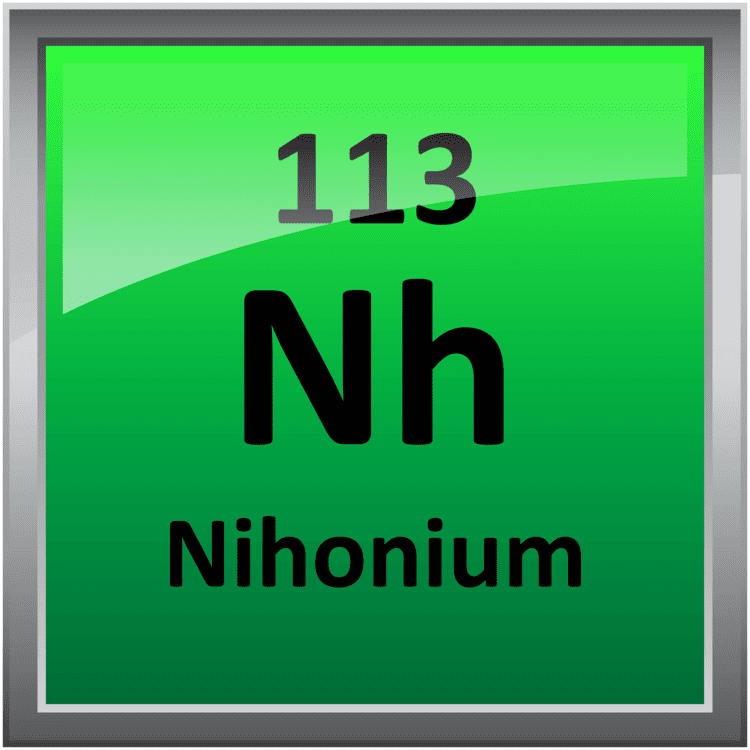Name, symbol nihonium, Nh Symbol Nh Discovered 2003 CAS ID 54084-70-7 | Mass number (most stable isotope) 286 Atomic mass 286 u Atomic number 113 | |
 | ||
Pronunciation /nɪˈhoʊniəm/ni-HOH-nee-əm Electron configuration [Rn] 5f 6d 7s 7p (predicted) Chemical series Metal, Boron group, Period 7 element | ||
Nihonium new element periodic table of videos
Nihonium is a chemical element with symbol Nh and atomic number 113. It is a synthetic element (an element that can be created in a laboratory but is not found in nature) and is extremely radioactive; its most stable known isotope, nihonium-286, has a half-life of 20 seconds. Nihonium was first reported to have been created in 2003 by the Joint Institute for Nuclear Research in Dubna, Russia, and in 2004 by a team of Japanese scientists at RIKEN. In December 2015, the International Union of Pure and Applied Chemistry (IUPAC) and the International Union of Pure and Applied Physics (IUPAP) recognized the element and assigned the priority of the discovery to RIKEN. In November 2016, the IUPAC published a declaration defining the name to be nihonium. The name comes from the common Japanese name for Japan (日本, nihon). On 28 November 2016, the name became official.
Contents
- Nihonium new element periodic table of videos
- Nihonium endorsed as new element s name
- DubnaLivermore collaboration
- RIKEN
- Naming
- Isotopes
- Stability and half lives
- Predicted properties
- Experimental chemistry
- References

In the periodic table, it is a p-block transactinide element. It is a member of the 7th period and is placed in the boron group, although it has not been confirmed to behave as the heavier homologue to thallium in the boron group. Nihonium is calculated to have some similar properties to its lighter homologues, boron, aluminium, gallium, indium, and thallium, and behave as a post-transition metal, although it should also show several major differences from them. Unlike all the other p-block elements, it may be able to involve its d-electrons in bonding, although these predictions are disputed.

Nihonium endorsed as new element s name
Dubna–Livermore collaboration

The first report of nihonium was in August 2003, when it was identified as an alpha decay product of element 115, moscovium. These results were published on February 1, 2004, by a team composed of Russian scientists at Dubna (Joint Institute for Nuclear Research), and American scientists at the Lawrence Livermore National Laboratory:

95Am
+ 48
20Ca
→ 288
115Mc
+ 3 1
0n
→ 284
113Nh
+
α
243
95Am
+ 48
20Ca
→ 287
115Mc
+ 4 1
0n
→ 283
113Nh
+
α

The Dubna–Livermore collaboration has strengthened their claim for the discovery of nihonium by conducting chemical experiments on 268Db, the final decay product of 288Mc. This was valuable as none of the nuclides in this decay chain were previously known, so that their claim was not supported by any previously obtained experimental data (as none existed), and chemical experimentation would strengthen the case for their claim. In June 2004 and again in December 2005, this dubnium isotope was successfully identified by extracting the final decay products, measuring spontaneous fission (SF) activities and using chemical identification techniques to confirm that they behave like a group 5 element (as dubnium is known to be in group 5 of the periodic table). Both the half-life and decay mode were confirmed for the proposed 268Db which lends support to the assignment of the parent and daughter nuclei to moscovium and nihonium respectively. Further experiments at Dubna in 2005 have fully confirmed the decay data for moscovium and nihonium, but in 2011, the IUPAC/IUPAP Joint Working Party (JWP) did not recognize the two elements as having been discovered because current theory could not distinguish between group 4 and group 5 elements by their chemical properties with sufficient confidence, and the identification of the daughter dubnium isotope was the most important factor in confirming the discovery of moscovium and nihonium. Furthermore, the decay properties of all the nuclei in the decay chain of moscovium had not been previously characterized before the Dubna experiments, a situation which the JWP generally considers "troublesome, but not necessarily exclusive".
RIKEN
On July 23, 2004, a team of Japanese scientists at RIKEN, led by Kōsuke Morita, bombarded a target of bismuth-209 with accelerated nuclei of zinc-70 and detected a single atom of the isotope nihonium-278. They published their results on September 28, 2004:
20983Bi
+ 70
30Zn
→ 278
113Nh
+ 1
0n
Previously, in 2000, a team led by P. A. Wilk identified the decay product 266Bh as decaying with identical properties to what the Japanese team had observed, thus lending support for their claim. However, they also observed the daughter of 266Bh, 262Db, undergo alpha decay instead of spontaneous fission (the Japanese team observed the latter decay mode).
The RIKEN team produced a further atom on April 2, 2005, although the decay data were slightly different from the first chain, perhaps due to either the formation of a metastable state or an alpha particle escaping from the detector before depositing its full energy. Due to these inconsistencies in the decay data, the small number of nihonium atoms produced, and the lack of unambiguous anchors to known isotopes, the JWP did not accept this as a conclusive discovery of nihonium in 2011.
Most recently, production and identification of another 278Nh atom occurred at RIKEN on August 12, 2012. In this case, a series of six alpha decays was observed, leading down to an isotope of mendelevium:
278113Nh
→ 274
111Rg
+
α
→ 270
109Mt
+
α
→ 266
107Bh
+
α
→ 262
105Db
+
α
→ 258
103Lr
+
α
→ 254
101Md
+
α
This decay chain differed from the previous observations at RIKEN mainly in the decay mode of dubnium, which was previously observed to undergo spontaneous fission, but in this case instead alpha decayed; the alpha decay of 262Db to 258Lr is well-known. The scientists on this team calculated the probability of accidental coincidence to be 10−28, or totally negligible. The resulting 254Md atom then underwent beta plus decay to 254Fm, which itself finally alpha decayed to the long-lived 250Cf, which has a half-life of around thirteen years.
Naming
Using Mendeleev's nomenclature for unnamed and undiscovered elements, nihonium should be known as eka-thallium. In 1979 IUPAC published recommendations according to which the element was to be called ununtrium (with the corresponding symbol of Uut), a systematic element name as a placeholder, until the discovery of the element is confirmed and a name is decided on. Although widely used in the chemical community on all levels, from chemistry classrooms to advanced textbooks, the recommendations were mostly ignored among scientists in the field, who called it "element 113", with the symbol of (113) or even simply 113.
Claims to the discovery of nihonium were put forward by both the Dubna and RIKEN teams. The Japanese team suggested various names: japonium, symbol Jp, after their home country; nishinanium, symbol Nh, after Japanese physicist Yoshio Nishina, the "founding father of modern physics research in Japan"; and rikenium, symbol Rk, after the team itself. In 2011, the IUPAC evaluated the 2004 RIKEN experiments and 2004 and 2007 Dubna experiments, and concluded that they did not meet the criteria for discovery.
On August 12, 2012, researchers at the RIKEN Nishina Center for Accelerator-Based Science in Japan, claimed to have successfully repeated their experiment and produced a third atom of 278Nh. In December 2015, IUPAC recognized the element and assigned the priority of the discovery to RIKEN, noting that while the individual decay energies of each nuclide in the decay chain of 278Nh were inconsistent, their sum was now confirmed to be consistent, strongly suggesting that the initial and final states in 278Nh and its daughter 262Db were the same through all the experiments, and that the decay of 262Db to 258Lr and 254Md was previously known, firmly anchoring the decay chain of 278Nh to known regions of the chart of nuclides. While the Dubna collaboration had also confirmed its results in 2013, their claim did not meet the discovery criteria as they had not convincingly determined the atomic numbers of their nuclides through cross-bombardments (making the daughters of 288Mc and 284Nh directly through other reactions), since their decay chains were not anchored to previously known nuclides. For the first time in history, a team of Asian physicists named a new element.
In March 2016, Kōsuke Morita, the leader of the RIKEN team, proposed the name "nihonium" to IUPAC, after its place of discovery and referencing Japanese chemist Masataka Ogawa's 1908 discovery of rhenium, which he named "nipponium". IUPAC accepted the proposal and set a term expiring 8 November to collect comments, after which the final name would be formally established at a conference.
On 8 June 2016, IUPAC disclosed the name of element 113 as nihonium. Prior to the formal approval by the IUPAC Council, a five-month public review was set, expiring 8 November 2016; the name was officially approved on 28 November 2016.
The sum argument advanced by the JWP in the approval of the discovery of nihonium was later criticized in a May 2016 study from Lund University and the GSI Helmholtz Centre for Heavy Ion Research, as it is only valid if no gamma decay or internal conversion takes place along the decay chain, which is not likely for odd nuclei, and the uncertainty of the alpha decay energies measured in the 278Nh decay chain was not small enough to rule out this possibility; and if this is the case, similarity in lifetimes of intermediate daughters become a meaningless argument, as different isomers of the same nuclide can have wildly different half-lives (the ground state of 180Ta has a half-life of mere hours, but an excited state 180mTa has never been observed to decay). However, although this study found reason to doubt and criticize the IUPAC approval of the discoveries of moscovium and tennessine, the data from RIKEN for nihonium was found to be congruent, and the data from the Dubna team for moscovium and nihonium to probably be so, thus necessitating no criticism of the IUPAC approval of the discovery of the element 113.
Isotopes
Nihonium has no stable or naturally occurring isotopes. Several radioactive isotopes have been synthesized in the laboratory, either by fusing two atoms or by observing the decay of heavier elements. Six different isotopes of nihonium have been reported with atomic masses 278 and 282–286; they all decay through alpha decay, although nihonium-284 may have an electron capture branch.
Stability and half-lives
All nihonium isotopes are extremely unstable and radioactive; however, the heavier nihonium isotopes are more stable than the lighter. The most stable known nihonium isotope, 286Nh, is also the heaviest known nihonium isotope; it has a half-life of 20 seconds. The isotope 285Nh has been reported to also have a half-life of over a second. The isotopes 284Nh and 283Nh have half-lives of 0.48 and 0.10 seconds respectively. The remaining two isotopes have half-lives between 0.1 and 100 milliseconds: 282Nh has a half-life of 70 milliseconds, and 278Nh, the lightest known nihonium isotope, is also the shortest-lived known nihonium isotope, with a half-life of just 0.24 milliseconds. It is predicted that even heavier undiscovered nihonium isotopes could be much more stable: for example, 287Nh is predicted to have a half-life of around 20 minutes, close to two orders of magnitude more than that of 286Nh.
Theoretical estimates of alpha decay half-lives of isotopes of nihonium are in good agreement with the experimental data. The undiscovered isotope 293Nh has been predicted to be the most stable towards beta decay; however, no known nihonium isotope has been observed to undergo beta decay.
The stability of nuclei decreases greatly with the increase in atomic number after plutonium, the heaviest primordial element, so that all isotopes with an atomic number above 101 decay radioactively with a half-life under a day, with the exception of dubnium-268. Nevertheless, because of reasons not very well understood yet, there is a slight increased nuclear stability around atomic numbers 110–114, which leads to the appearance of what is known in nuclear physics as the "island of stability". This concept, proposed by University of California professor Glenn Seaborg, explains why superheavy elements last longer than predicted.
Predicted properties
Nihonium is the first member of the 7p series of elements and the heaviest group 13 element on the periodic table, below boron, aluminium, gallium, indium, and thallium. It is predicted to show many differences from its lighter homologues: a largely contributing effect is the spin–orbit (SO) interaction. It is especially strong for the superheavy elements, because their electrons move much faster than in lighter atoms, at velocities comparable to the speed of light. In relation to nihonium atoms, it lowers the 7s and the 7p electron energy levels (stabilizing the corresponding electrons), but two of the 7p electron energy levels are stabilized more than the other four. The stabilization of the 7s electrons is called the inert pair effect, and the effect "tearing" the 7p subshell into the more stabilized and the less stabilized parts is called the subshell splitting. Computation chemists see the split as a change of the second (azimuthal) quantum number l from 1 to 1/2 and 3/2 for the more stabilized and less stabilized parts of the 7p subshell, respectively. For many theoretical purposes, the valence electron configuration may be represented to reflect the 7p subshell split as 7s27p1/21. These effects stabilize lower oxidation states: the first ionization energy of nihonium is expected to be 7.306 eV, the highest in group 13. Hence, the most stable oxidation state of nihonium is predicted to be the +1 state, and nihonium is expected to be less reactive than thallium. Differences for other electron levels also exist. For example, the 6d electron levels (also split in halves, with four being 6d3/2 and six being 6d5/2) are both raised, so that they are close in energy to the 7s ones. Thus, the 6d electron levels, being destabilized, should still be able to participate in chemical reactions in nihonium (as well as in the next 7p element, flerovium), thus making it behave in some ways like transition metals and allow higher oxidation states. Nihonium should hence also be able to show stable +3 and possibly also +5 oxidation states. However, the +3 state should still be less stable than the +1 state, following periodic trends. Nihonium should be the most electronegative among all the group 13 elements: for example, in the compound NhTs, the negative charge is expected to be on the nihonium atom rather than the tennessine atom, the opposite of what would be expected from simple periodicity. The electron affinity of nihonium is calculated to be around 0.68 eV; in comparison, that of thallium is 0.4 eV. The high electron affinity and electronegativity of nihonium are due to it being only one electron short of the closed-shell valence electron configuration of flerovium (7s27p1/22): this would make the −1 oxidation state of nihonium more stable than that of its lighter congener thallium. The standard electrode potential for the Nh+/Nh couple is predicted to be −0.6 V.
The simplest possible nihonium compound is the monohydride, NhH. The bonding is provided by the 7p1/2 electron of nihonium and the 1s electron of hydrogen. However, the SO interaction causes the binding energy of nihonium monohydride to be reduced by about 1 eV and the nihonium–hydrogen bond length to decrease as the bonding 7p1/2 orbital is relativistically contracted. This is exceptional in the 7p series of elements; all other MH (M = Fl, Mc, Lv, Ts, Og) molecules have relativistic expansion of the bond length instead of contraction. The analogous monofluoride (NhF) should also exist. Nihonium should also be able to form the trihydride (NhH3), trifluoride (NhF3), and trichloride (NhCl3), with nihonium in the +3 oxidation state. Because the 6d electrons are involved in bonding instead of the 7s ones, these molecules are predicted to be T-shaped and not trigonal planar. Although the polyfluoride anion NhF−
6 should be stable, the corresponding neutral fluoride NhF5 should be unstable, spontaneously decomposing into the trifluoride and elemental fluorine. Nihonium(I) is predicted to be more similar to silver(I) than thallium(I): the Nh+ ion is expected to more willingly bind anions, so that NhCl should be quite soluble in an excess of hydrochloric acid or in ammonia while TlCl is not. Additionally, in contrast to the strongly basic TlOH, nihonium(I) should instead form Nh2O, which would be weakly water-soluble and readily ammonia-soluble.
Nihonium is expected to be much denser than thallium, having a predicted density of about 16 to 18 g/cm3, due to the relativistic stabilization and contraction of its 7s and 7p1/2 orbitals. This is because calculations estimate it to have an atomic radius of about 170 pm, the same as that of thallium, even though periodic trends would predict it to have an atomic radius larger than that of thallium due to it being one period further down in the periodic table. The melting and boiling points of nihonium are not definitely known, but have been calculated to be 430 °C and 1100 °C respectively, exceeding the values for gallium, indium, and thallium, following periodic trends.
Experimental chemistry
Unambiguous determination of the chemical characteristics of nihonium has yet to have been established. The isotopes 284Nh, 285Nh, and 286Nh have half-lives long enough for chemical investigation. It is theoretically predicted that nihonium should have an enthalpy of sublimation around 150 kJ/mol and an enthalpy of adsorption on a gold surface around −159 kJ/mol. From 2010 to 2012, some preliminary chemical experiments were performed to determine the volatility of nihonium. The reaction used was 243Am(48Ca,3n)288Mc; the isotope 288Mc has a short half-life and would quickly decay to the longer-lived 284Nh, which would be chemically investigated. Teflon capillaries at 70 °C connecting the recoil chamber, where the nihonium atoms were synthesized, and the gold-covered detectors: the nihonium atoms would be carried along the capillaries by a carrier gas. While about ten to twenty atoms of 284Nh were produced, none of these atoms were registered by the gold-covered detectors, suggesting either that nihonium was similar in volatility to the noble gases or, more plausibly, that pure nihonium was not very volatile and thus could not efficiently pass through the Teflon capillaries at 70 °C. Formation of the hydroxide NhOH would ease the transport, as NhOH is expected to be more volatile than elemental nihonium, and this reaction could be facilitated by adding more water vapor into the carrier gas. However, it seems likely that this formation is not kinetically favored, so that one would need to use the longer-lived isotope 286Nh in future experiments.
